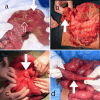Clinical Presentation, Diagnosis, and Management of Abdominal Tuberculosis in Pediatric Population: A Prospective Descriptive Study From a Tertiary Care Centre in North India
- PMID: 40978883
- PMCID: PMC12446891
- DOI: 10.7759/cureus.90491
Clinical Presentation, Diagnosis, and Management of Abdominal Tuberculosis in Pediatric Population: A Prospective Descriptive Study From a Tertiary Care Centre in North India
Abstract
Aims Abdominal tuberculosis (TB) continues to be a common and challenging abdominal disease in children, with a nonspecific clinical presentation and poor outcomes in delayed diagnosis and complicated cases. We aimed to prospectively evaluate the clinical features and diagnostic workup of children with suspected abdominal TB, with a focus on early initiation of medical and surgical treatment and monitoring of therapeutic outcomes. Materials and methods A time-bound prospective observational study of all patients ≤ 17 years requiring admission with symptoms suggestive of abdominal TB from February 2020 to May 2023 was conducted. All necessary routine blood tests and imaging were done, and endoscopies and surgeries as needed by the patient were carried out. The data of the patients who were diagnosed as abdominal TB - probable or definitive - were analyzed. Results Forty-seven patients were recruited with a suspected diagnosis of abdominal TB. Thirty-four patients (24 females and 10 males) were diagnosed as abdominal TB - definite in 18/34 patients (52.94%) and probable in 16/34 patients (47.06%). The mean age was 12.20 ± 3.82 years (4-17 years). Median duration of the symptoms was three months (IQR = 1-5 months). The commonest symptoms were abdominal pain (94.11%), fever (73.52%), and loss of appetite and weight (70.58%). Twelve patients (35.29%) gave a positive history of contact with TB. There were 13/34 (38.23%) patients who had concomitant pulmonary and abdominal TB, and 21/34 (61.76%) patients who had only abdominal TB. Mantoux tuberculin skin test was performed in 20 patients, of which 9/20 (45%) were positive. A Cartridge-Based Nucleic Acid Amplification Test (CBNAAT) was performed in 30/34 patients (88.23%) from fluid or tissue samples, of which 11 patients (35.48%) showed CBNAAT positivity. Fifteen patients (44.11%) underwent surgery, 12 for intestinal perforation and three for intestinal obstruction. Out of the 18 definite cases of abdominal TB, 11/18 (61.111%) were CBNAAT positive, and 10/18 (55.55%) had histopathology suggestive of TB. The 16 probable cases of abdominal TB had a strong history and imaging suggestive of TB abdomen. A total of seven patients who underwent surgery for intestinal perforation expired. One patient developed a relapse, and four patients developed drug-induced liver injury (DILI). Conclusion Abdominal TB remains a common cause of acute abdomen in the pediatric population, often presenting with non-specific features and lacking a definitive diagnostic modality. Early detection through recognition of common clinical features, guided imaging, and timely sampling for confirmation is vital for initiating antitubercular therapy (ATT) and improving outcomes in abdominal TB.
Keywords: abdominal tuberculosis; cbnaat; children; intestinal; koch’s abdomen; mycobacterium tuberculosis.
Copyright © 2025, Yhoshu et al.
Conflict of interest statement
Human subjects: Informed consent for treatment and open access publication was obtained or waived by all participants in this study. All India Institute of Medical Sciences, Rishikesh, Institutional Ethics Committee issued approval AIIMS/IEC/20/124. Animal subjects: All authors have confirmed that this study did not involve animal subjects or tissue. Conflicts of interest: In compliance with the ICMJE uniform disclosure form, all authors declare the following: Payment/services info: All authors have declared that no financial support was received from any organization for the submitted work. Financial relationships: All authors have declared that they have no financial relationships at present or within the previous three years with any organizations that might have an interest in the submitted work. Other relationships: All authors have declared that there are no other relationships or activities that could appear to have influenced the submitted work.
Figures




References
-
- World Health Organization. Global tuberculosis report. 201820182018. https://iris.who.int/handle/10665/274453 https://iris.who.int/handle/10665/274453
-
- Extrapulmonary tuberculosis. Sharma SK, Mohan A. https://pubmed.ncbi.nlm.nih.gov/15520485/ Indian J Med Res. 2004;120:316–353. - PubMed
-
- Intestinal tuberculosis: return of an old disease. Horvath KD, Whelan RL. Am J Gastroenterol. 1998;93:692–696. - PubMed
-
- Imaging of abdominal tuberculosis. Akhan O, Pringot J. Eur Radiol. 2002;12:312–323. - PubMed
LinkOut - more resources
Full Text Sources
